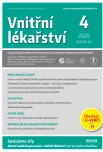Heparin-induced thrombocytopenia: a case report and literature overview
Authors:
Pavel Polák 1; Yvona Kaloudová 2; Hana Krupicová 2; Pavel Coufal 2; Břetislav Lipový 2; Jiřina Zavřelová 1,3; Marie Prudková 1,3; Andrea Štěpařová 1,3; Lucie Říhová 1,3; Renata Bezděková 1; Romana Králová 1; Lukáš Frola 4; Miroslav Penka 1,3
Authors‘ workplace:
Oddělení klinické hematologie FN Brno, pracoviště Bohunice
1; Klinika popálenin a plastické chirurgie LF MU a FN Brno, pracoviště Bohunice
2; Katedra laboratorních metod LF MU Brno
3; Ústav patologie LF MU a FN Brno, pracoviště Bohunice
4
Published in:
Vnitř Lék 2020; 66(4): 242-248
Category:
Case Report
Overview
Heparin-induced thrombocytopenia (HIT) is an immunologically-mediated complication, which usually follows heparin exposition, less frequently exposition to other drugs or even occurs spontaneously. The type of heparin, its dose and mode of application as well as the exposition time, major trauma or operation, and obesity represent the main risk factors for HIT. The probability of HIT correlates with so-called 4T-score. A confirmatory laboratory diagnostic should be exclusively reserved for patients with a medium to a high probability of HIT development (more than 3 points in 4T-score). The screening method is based on serological detection of antibodies against heparin-platelet factor-4 complexes; confirmation tests aim to identify the activation of platelets. The treatment of HIT requires an immediate interruption of heparin application and rigorous antithrombotic treatment with an alternative agent. Herein authors describe a clinical case of HIT manifested as an extreme urticarial reaction in the location of nadroparin application as well as thrombosis of deep subcutaneous veins in a polymorbid obese patient with an extensive and infected burn. Due to timely diagnosis and fondaparinux treatment, no more severe thrombotic events occurred in this patient.
Keywords:
thrombosis – direct oral anticoagulants – fondaparinux – heparin‑induced thrombocytopenia – 4T-scores
Sources
1. Králová S, Klodová D, Gumulec J, et al. Heparinem indukovaná trombocytopenie. Vnitř Lék 2006; 52: (Suppl. 1): 98–106.
2. Cuker A, Arepally GM, Chong BH, et al. American Society of Hematology 2018 guidelines for management of venous thromboembolism: heparin‑induced thrombocytopenia. Blood Adv 2018; 2 : 3360–3392.
3. Fathi M. Heparin‑induced thrombocytopenia (HIT): Identification and treatment pathways. Glob Cardiol Sci Pract 2018; 2018 : 15.
4. Bloom MB, Zaw AA, Hoang DM, et al. Body mass index strongly impacts the diagnosis and incidence of heparin‑induced thrombocytopenia in the surgical intensive care unit. J Trauma Acute Care Surg 2016; 80 : 398–403.
5. Mattioli AV, Manenti A, Farinetti A. Impact of obesity on heparin‑induced thrombocytopenia in cardiac surgery patients. Blood Coagul Fibrinolysis 2018; 29 : 661.
6. Linkins LA, Bates SM, Lee AY, et al. Combination of 4Ts score and PF4/H‑PaGIA for diagnosis and management of heparin‑induced thrombocytopenia: prospective cohort study. Blood 2015; 126 : 597–603.
7. Thomson J, Kuriakose P, To L, et al. Development of an algorithm for the systematic evaluation of patients with suspected heparin‑induced thrombocytopenia. J Thromb Thrombolysis 2019; 478–480.
8. Zheng G, Streiff MB, Allison D, et al. A novel diagnostic algorithm for heparin‑induced thrombocytopenia. Int J Lab Hematol 2018; 527–532.
9. Dhakal B, Kreuziger LB, Rein L, et al. Disease burden, complication rates, and health‑care costs of heparin‑induced thrombocytopenia in the USA: a population‑based study. Lancet Haematol 2018; 5: e220–e231.
10. Favaloro EJ. Laboratory tests for identification or exclusion of heparin induced thrombocytopenia: HIT or miss? Am J Hematol 2018; 93 : 308–314.
11. Warkentin TE, Sheppard JI, Linkins LA, et al. High sensitivity and specificity of an automated IgG‑specific chemiluminescence immunoassay for diagnosis of HIT. Blood 2018; 132 : 1345–1349.
12. Warkentin TE, Arnold DM, Nazi I, et al. The platelet serotonin‑release assay. Am J Hematol 2015; 90 : 564–572.
13. Warkentin TE, Anderson JA. How I treat patients with a history of heparin‑induced thrombocytopenia. Blood 2016; 128 : 348–359.
14. Riegerová B, Malý R, Lojík M, et al. Heparinem indukovaná trombocytopenie II. typu u komplikované ileofemorální flebotrombózy léčené katétrem řízenou trombolýzou. Interv Akut Kardiol 2007; 7 : 74–77.
15. Bosch‑Amate X, Fustà‑Novell X, Mascaró‑Gally JM. Trombocitopenia trombótica inducida por heparina: una entidad rara potencialmente grave. Aten Primaria 2019; article in press (available from: https://www.sciencedirect.com/science/article/pii/S0212656718306681; accessed Feb 5th, 2019).
16. Omer T, Mullaguri N, George P et al. False‑negative platelet factor 4 antibodies and serotonin release assay and the utility of repeat testing in the diagnosis of heparin‑induced thrombocytopenia and thrombosis. Case Rep Hematol 2019; 2019 : 1585014.
17. Maharaj S, Chang S. Anti‑PF4/heparin antibodies are increased in hospitalized patients with bacterial sepsis. Thromb Res 2018; 171 : 111–113.
18. Lo GK, Sigouin CS, Warkentin TE. What is the potential for overdiagnosis of heparin induced thrombocytopenia? Am J Hematol 2007; 82 : 1037–1043.
19. Schindewolf M. Fondaparinux in heparin‑induced thrombocytopenia: A decade’s worth of clinical experience. Res Pract Thromb Haemost 2019; 3 : 9–11.
20. Warkentin TE, Pai M, Linkins LA. Direct oral anticoagulants for treatment of HIT: update of Hamilton experience and literature review. Blood 2017; 130 : 1104–1113.
21. Linkins LA, Warkentin TE, Pai M, et al. Rivaroxaban for treatment of suspected or confirmed heparin‑induced thrombocytopenia study. J Thromb Haemost 2016; 14 : 1206–1210.
22. Mohanty E, Nazir S, Sheppard JI, et al. High‑dose intravenous immunoglobulin to treat spontaneous heparin‑induced thrombocytopenia syndrome. J Thromb Haemost 2019; XXX: XXX–XXX.
23. Zapletal O, Blatný J, Štarha J Heparinem indukovaná trombocytopenie při léčbě nízkomolekulárními hepariny u dětí. Je čeho se obávat? Vnitř Lék 2010; 56: (Suppl. 1): S55–S57.
Labels
Diabetology Endocrinology Internal medicineArticle was published in
Internal Medicine

2020 Issue 4
Most read in this issue
- Liver fibrosis
- Evaluation of surgical risk in patients with liver cirrhosis
- Microscopic polyangiitis
- Hyperuricemia in renal disease patients
